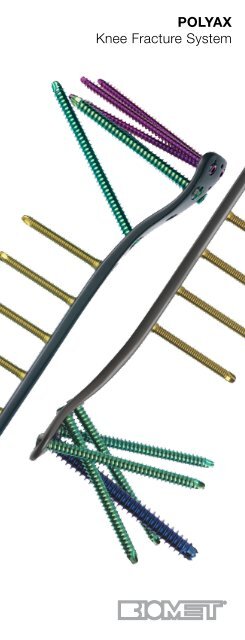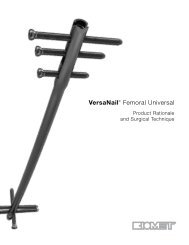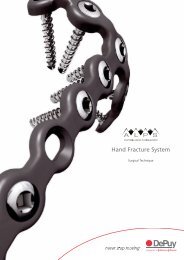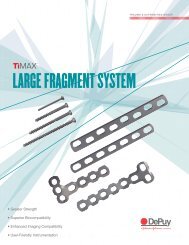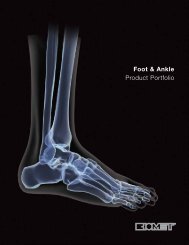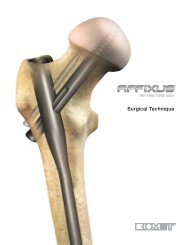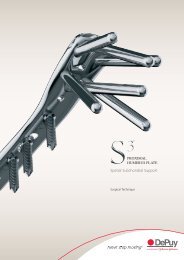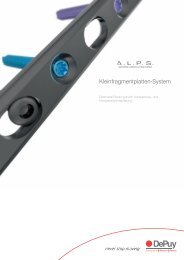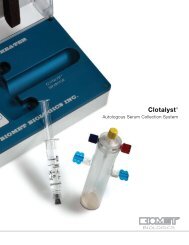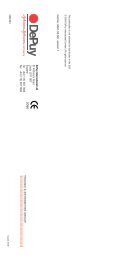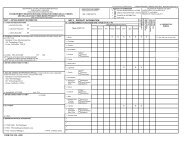POLYAX Knee Fracture System - Biomet
POLYAX Knee Fracture System - Biomet
POLYAX Knee Fracture System - Biomet
Create successful ePaper yourself
Turn your PDF publications into a flip-book with our unique Google optimized e-Paper software.
Trauma Selling Guidefor the <strong>POLYAX</strong> ® <strong>Knee</strong> <strong>Fracture</strong> <strong>System</strong>IntroductionThe <strong>POLYAX</strong> <strong>Knee</strong> <strong>Fracture</strong> <strong>System</strong> is a lockingplate system that treats a wide range of distal femurand proximal tibia fractures for either percutaneousor open procedures. The design is intended foruse in fracture fixation cases requiring OpenReduction Internal Fixation (ORIF) for closed andopen fractures of the distal femur and proximaltibia, including repair of non-unions, malunionsand fractures including but not limited to simplecomminuted, lateral wedge, depression, medialwedge, bicondylar, combinations of lateral wedgeand depression and fractures with associated shaftfractures.The <strong>POLYAX</strong> Plating <strong>System</strong> allows surgeons tocapture and reduce fragments from any anglewithin a 30º cone of angulation, enabling them todeal with the uniqueness and complexity of theperiarticular fracture. The surgeon can target thebest bone available for his or her screw placementinstead of the screw direction being determined bythe plate design.CONFIDENTIAL —Intended solely for <strong>Biomet</strong> Distributors and their sales associates.3
<strong>POLYAX</strong><strong>Knee</strong> <strong>Fracture</strong> <strong>System</strong>Features and Benefits<strong>POLYAX</strong> Screw/Plate <strong>System</strong> TechnologyThe screw and plate technology allow for freedomof screw position at any desired angle within a 30ºcone of angulation. This patented technology alsoallows for locking and lag screw options.4
Anatomically Contoured PlateAnatomically shaped locking plates designedto fit the lateral aspect of the distal femur andproximal tibia. Multiple plate lengths are availableto accommodate various clinical indications andeliminate intraoperative contouring.Femoral PlateTibial PlateMultiple Screw Options/Plate ConstructThese plates have maximum stability and fixationwith multiple screw options; variable anglelocking, fixed angle locking, non-locking, cortical,cancellous, unicortical and bicortical.CONFIDENTIAL —Intended solely for <strong>Biomet</strong> Distributors and their sales associates.5
Color-Coded Screws and InstrumentationThere is a minimal amount of instrumentationrequired. This instrumentation enables the surgeonto utilize a percutaneous or standard opentechnique for plate and screw placement. Theinstrumentation and screws are color-coded foreasy identification and selection in the OR.Plate Strength<strong>POLYAX</strong> was evaluated in a clinical study doneat the Mayo Clinic. The <strong>POLYAX</strong> plate was thestrongest low-profile plate tested. <strong>POLYAX</strong>beat Synthes LCP, Smith & Nephew, Peri-Lockand Stryker plates in repetitive load to failuretesting. This article will be published in Journal ofOrthopaedic Trauma in later 2009.6
Interview QuestionsThe first and most obvious thing you’ll need tofind out from your surgeon is what treatmentmethod he or she is using for peri and intra-articularfractures, particularly those around the knee. Bearin mind that fracture treatment around the knee caninclude methods other than traditional (non-locking)or locking plate systems, such as thin wire externalfixators or even IM nails. Therefore, stay flexible andbe prepared to discuss a variety of options withinthe trauma portfolio.Distal FemurIn using a locked fixed angle device, areyou able to address individual fracturefragments and optimally place lockingscrews in good bone?With the <strong>POLYAX</strong> <strong>System</strong>, you are able to optimallyplace your screws and address individual fracturefragments with locked and/or compression screws.How are you currently treatingperiprosthetic fractures above atotal knee?The <strong>POLYAX</strong> <strong>System</strong> has the ability to capture andreduce fragments from any angle within a 30º coneof angulation. This allows the surgeon to target thebest bone and maneuver around obstacles such astotal knee implants or previously placed screws.The implant is ideal for treating periprostheticfractures. Other competitor systems don’t offer thiscapability.Are you able to get adequate distalfixation with a single DCS screw?The <strong>POLYAX</strong> <strong>System</strong> allows you to do apercutaneous plate that also maximizes distalfixation of the fracture.CONFIDENTIAL —Intended solely for <strong>Biomet</strong> Distributors and their sales associates.7
Proximal TibiaWhen treating tibial plateau fractures,do you feel you always get adequateproximal fixation with fixed angle screws?The <strong>POLYAX</strong> Tibia plate allows the surgeon toplace screws in optimal position and obtain astronger construct than fixed angle locked screwsin suboptimal position.What are you currently using to treat yourperiarticular tibial plateau fractures? Ifyou’re using non-locked plates, are youconcerned with screws backing out?The <strong>POLYAX</strong> <strong>System</strong> offers locked screws thatcontrol intra-articular fragments.Objection HandlingThe screw will fail because the polyaxialbushing is not a true locked construct.The polyaxial construct utilizes a patented rotationallocking bushing to fix the screw position in theplate at any desired angle within the 30º cone ofangulation. As the tapered portion of the screwhead is tightened into the bushing, the taperexpands the bushing and provides a friction lock tothe plate.In 2007, a Journal of Bone and Joint Surgeryarticle written by George Haidukewych, etal, was published to support the evolution ofpolyaxial locking plates. This study evaluated theperformance of the variable locking plate in severalperiarticular fractures about the knee. Results fromthis study showed that the patients who received<strong>POLYAX</strong> plate had no mechanical complicationsand no polyaxial screw failure. In fact, 94% of thepatients in the study had union.8
The jig is not very sturdy.On the contrary, many surgeons like the jig due toits simplistic design. The jig targets well and doesn’tinterfere with the surgeon’s ability to visually see thearticular surface.The <strong>POLYAX</strong> tibia plate sits more anteriorthan competitive plates.The tibial plate was designed to enable the 4.0 mmscrews to be placed in the subchondral bone andlock to the plate, creating a more stable construct.With the competitive plates, the subchondralscrews are placed outside the plate.The <strong>POLYAX</strong> plate can’t be contoured.The <strong>POLYAX</strong> plates have been pre-contouredto match the anatomy. Bending and twisting ofthe plate is not recommended, as this can resultin the misalignment of the target guide with thecorresponding plate holes. It can result in thedistortion of a locking hole making locking screwsto the plate difficult.Why is it necessary to use atorque-limiting screwdriver?The torque-limiting screwdriver should be usedfor all final tightening of the locking screws. Thishelps to prevent excess torque being applied to thescrew heads which can lead to stripping of the hexor over tightening of the screw, which can then leadto cold welding of the screw to the plate. The screwis securely locked to the plate when an audible clickis heard.CONFIDENTIAL —Intended solely for <strong>Biomet</strong> Distributors and their sales associates.9
Competitive ComparisonsSee THe following pages 9-12 forcompetitive comparisons charts10
Distal Femur: Competition OverviewMANUFACTURER Synthes Synthes Stryker Smith & Nephew ZimmerPRODUCT<strong>POLYAX</strong> LISS LCP Numelock II AxSOS Periloc NCB DistalFemoral <strong>System</strong>PeriarticularPlating <strong>System</strong>MATERIALTiMAX (Titanium)Ti6-AL-4VTitaniumTi6-AL-7NbStainless Steel316LStainless Steel316LVMStainless Steel Stainless Steel316LProtasul-64 Metal Alloy Stainless Steel316LLOCKING OPTIONSPolyaxial lockingand fixed lock optionsFixed lock Fixed lock.Combinatio hole forcompression anddynamization options.Polyaxial lockingoptionsFixed lock Fixed lock Polyaxial lockingoptionsFixed lockANGULATION4 polyaxial screws in head of plate canbe angled up to 30 degrees in all planesand locked.Central 8.0 mm screw is fixed at a 95degree angle.Shaft screws are locked at 90 degrees.All screws are lockedat 90 degrees.All screws are lockedat 90 degrees.Screws in the headof the plate can beangled in 30 degreecone.Shaft screws arenon-locking.Distal screws lock at95 degrees. Shaftscrews have a 70 axialangulation and30 degree transverseangulationDistal screws are locked at 95 degrees.Shaft screws are locked at 90 degrees.Screws in the headof the plate can beangled in 30 degreecone. The shaft screwsAll screws are lockedat 90 degrees.INSERTION TECHNIQUEPercutaneous - externaltarget guide.Percutaneous- externaltarget guide.standard opentechniqueMinimally invasive- noexternal target guide.percutaneous-externaltarget guidePercutaneous - noexternal target guideMinimally invasive Minimally invasive- no external targetguide.PLATECONFIGURATION1 central locking hole surrounded by 4polyaxial locking holes in the plate head.2 distal k-wire holes.Shaft holes are threaded forplacement of locking or non-lockingscrews.7 Distal threadedplate holes in theplate head.2 distal k-wire holes.Shaft holes arethreaded for lockingscrews.1 Central threadedhole surrounded by 5threaded holes in theplate head.Shaft holes are acombination holeallowing for placementof locking ornon-locking screws5 polyaxial lockingholes in the plate head.Shaft holes arenon-locking.3 unthreadedmetaphyseal holes5 Distal threaded holes in the plate headwith scalloped edges for easy placementof independent lag screws.1 distal k-wire hole.Shaft holes are threaded and accept lockingor non-locking screws.6 Distal threaded holesin the plate. The shaftholes have non-lockingscrews, but arelocked with a screwcap.6 Threaded distalholes in the platehead. One threadedstrut screw hole in theplate neck.Alternating threadedround holes andnon-threaded ovalholes on the shaft.11CONFIDENTIAL —Intended solely for <strong>Biomet</strong> Distributors and their sales associates.
CONTOURINGCOMPRESSIONPLATE LENGTHSSCREWSHOP = HEAD OF PLATENOP = NECK OF PLATESOP = SHAFT OF PLATEPlates are anatomically contoured to fit theshape of the bone.Can compress the plate to the bone withnon-locking screws, bone clamp and anchorbolt. Can only compress the fracturethrough the plate by the use of anarticulating tension device.6 Holes- 179.4 mm9 Holes- 233.5 mm12 Holes- 287.6 mm15 Holes- 341.7 mm18 Holes- 395.8 mmHOP -1 Central 8.0 mm cannulatedcancellous self-drilling locking and 4 (5.5mm cancellous) locking and non-lockingSOP - 4.5 mm cortical locking ornon-lockingPlates are anatomicallycontoured to fitthe shape of the bone.Uses a pull reductioninstrument to guidethe fracture pieces tothe plate. Does notallow for compressionof the fracture throughthe plate.5 Holes- 156 mm9 Holes- 236 mm13 Holes- 316 mm5.0 mm Unicortical,self-drilling screwsPlates are anatomicallycontoured to fitthe shape of the bone.Accepts articulatedtension device toprovide compressionor distraction.Locking compressionholes combine withdynamization holes inthe shaft to achieve 1mm of compression.6 Holes - 167 mm9 Holes - 221 mm12 Holes - 275 mm15 Holes - 329 mm18 Holes - 383 mmHOP - 7.3 mm cannulatedlocking or conicalscrew and 5.0 mmcannulated locking orconical screw; or 4.5mm cortex screw.SOP - 4.0 mm lockingscrew or 4.5 mmcortex screwPlates are pre-shaped,but the diaphysealportion can becontoured prior toinsertion with platebending irons.Uses a pull reductioninstrument to guide thefracture pieces to theplate. Can compressthe plate to the bonewith the use of nonlockingscrews. Cannotcompress the fracturethrough the plate.5 Holes - 124 mm7 Holes - 158 mm9 Holes - 192 mm11 Holes - 226 mmHOP - 6.5 mmCancellous lockingSOP - 4.5 mm Corticalnon-lockingPlates are anatomicallycontoured to fitthe shape of the bone.Can compress thefracture through theplate with non-lockingscrews.4 Holes- 130 mm6 Holes- 166 mm8 Holes- 202 mm10 Holes-238 mm12 Holes- 274 mm14 Holes- 310 mm16 mm-343 mmHOP-4.5 mm CorticalScrew SOP-4.5 mmCortical Screw; 5.0mm Locking ScrewPlates are anatomically contoured to fit theshape of the boneAccepts articulated tension device toprovide compression or distraction.Oversized round holes in the plate shaftcan be used for 1 mm of compression.6 Holes - 155 mm8 Holes - 193 mm10 Holes - 230mm13 Holes - 286 mm16 Holes - 342 mm19 Holes - 399 mmHOP - 5.7 mm Cannulated lockingor 4.5 mm Cortical lockingNOP - 5.7 mm Cannulated lockingor 6.5 mm Cancellous non-lockingSOP - 4.5 mm Cortical lockingor non-locking, unicortical and bicorticalPlates are anatomicallycontoured to fit theshape of the boneBone spacers areused to apply screwcompression alongwith the use ofnon-locking screws.5 Holes- 167 mm9 Holes- 246 mm13 Holes- 324 mmHOP- 6.2 mmCancellous Screwsnon-locking (lockedwith screw cap)SOP-6.0 mm Corticalnon-locking that lockwith a screw capPlates are anatomicallycountoured tofit the shape of thebone.Accepts tensiondevice to providecompression. Cancompress the plate tothe bone with the useof non-locking screws.Oval compressionholes allow compressionof the fracturethrough the plate.6 Holes - N/A10 Holes - N/A14 Holes - N/A18 Holes - N/AHOP - 5.5cannulated lockingand 5.5 conicalSOP - 4.5 mm lockingor non-locking,unicortical or bicortical12
Proximal Tibia: Competition OverviewMANUFACTURER <strong>Biomet</strong> Synthes Synthes Stryker Smith & NephewPRODUCT <strong>POLYAX</strong> LISS LCP Numelock II PerilocMATERIALTiMAX (Titanium)Ti6-AL-4VTitaniumTi6-AL-7NbStainless Steel316LStainless Steel316LVMStainless Steel316LLOCKING OPTIONSPolyaxial lockingand fixed lock optionsFixed lock Fixed lock. Combination hole for compressionanddynamization options.Polyaxial locking in metaphyseal regiononly.Fixed lockANGULATIONScrews in head of plate can be angled up to30 degrees in all planes and locked.Shaft screws are locked at 90 degrees.All screws are locked at 90 degrees. The screws in the head and shaft of theplate are locked at 90 degrees. Theproximal two screws in the metaphysealregion do not lock and the third one locksat a predetermined angle.Screws in the head of the plate can beangled in 30 degree cone.Shaft screws are non-locking.Screws in the head and shaft of theplate are locked at 90 degrees. Thetwo screws in the neck area are lockedat pre-determined angles.INSERTION TECHNIQUEPercutaneous- external target guide. Percutaneous- external target guide. Minimally invasive- No external targetguide.Minimally invasive- no external targetguide.Percutaneous - no external targetguidePLATE CONFIGURATIONRow of 3 polyaxial locking holes (4.0 mm) inthe proximal plate head above a triangluararrangement of 3 polyaxial locking holes(5.5mm) in the head/neck area of the plate.3 proximal k-wire holes.Shaft holes are threaded for placement oflocking or non-locking screws.Triangular arrangement of 3 threadedproximal holes in the plate head above2 additional threaded holes in the neckarea of the plate.Shaft holes are threaded for lockingscrews.Row of 3 proximal threaded holes inplate head. 2 non-threaded round holesand 1 proximally threaded angled holein plate neck.2 proximal k-wire holes.Shaft holes are a combination holeallowing for placement of locking or nonlockingscrews.L-shape with a proximal row of 2 polyaxiallocking holes in plate head and one polyaxiallocking hole below those in the neckof the plate.Shaft holes are non-locking.L-shape with 3 proximal locking holesin the plate head above 2 additionallocking holes angled proximally in theplate neck.3 proximal k-wire holes.Shaft holes are threaded and acceptlocking or non-locking screws.CONTOURINGPlates are anatomically contoured to fit theshape of the bone.Plates are anatomically contoured tofit the shape of the bone.Plates are anatomically countoured to fitthe shape of the bone.Plates are pre-shaped, but the diaphysealportion can be contoured prior to insertionwith plate bending irons.Plates are anatomically contoured to fitthe shape of the bone13CONFIDENTIAL —Intended solely for <strong>Biomet</strong> Distributors and their sales associates.
COMPRESSIONPLATE LENGTHSSCREWSHOP = HEAD OF PLATENOP = NECK OF PLATESOP = SHAFT OF PLATECan compress the plate to the bone withnon-locking screws, bone clamp and anchorbolt. Can only compress the fracture throughthe plate by the use of an articulating tensiondevice.2 Hole- 99.6 mm5 Hole- 153.7 mm8 Hole- 207.8 mm11 Hole- 261.9 mm14 Hole- 316.0 mmHOP - 4.0 mm Cancellous locking andnon-lockingH/NOP - 5.5 mm Cancellous locking andnon-lockingSOP - 4.5 mm Cortical locking and nonlocking,unicortical and bicorticalUses a pull reduction instrument toguide the fracture pieces to the plate.Does not allow for compression of thefracture through the plate.Accepts articulated tension device toprovide compression or distraction.Locking compression holes combine withdynamization holes in the shaft to achieve1 mm of compression.5 Hole- 140 mm9 Hole- 220 mm13 Hole- 300 mm4 Hole- 82 mm6 Hole 118 mm8 Hole- 154 mm10 Hole - 190 mm12 Hole- 226 mm14 Hole- 262 mm5.0 mm Unicortical, self-drilling screws 4.5 mm PlateHOP - 5.0 mm Cannulated locking ornon-lockingNOP - 4.5 mm Cortical and 6.5 mmCancellous non-lockingNOP - 5.0 mm Cannulated locking obliqueSOP - 4.0 mm locking or 4.5 mm Corticalnon-locking, unicortical and bicorticalINFORMATION ON ZIMMER’S PERIARTICULAR TIBIAL PLATE IS NOT AVAILABLEUses a pull reduction instrument to guidethe fracture pieces to the plate. Can compressthe plate to the bone with the use ofnon-locking screws. Cannot compress thefracture through the plate.4 Hole - 84 mm5 Hole - 97 mm6 Hole - 110 mm7 Hole - 123 mmHOP - 6.5 mm Cancellous lockingSOP - 4.5 mm Cortical non-lockingAccepts articulated tension device toprovide compression or distraction.Oversized round holes in the plateshaft can be used for 1 mm ofcompression.3.5 mm Plate4 Hole - 73 mm6 Hole - 98 mm8 Hole - 123 mm10 Hole - 149 mm13 Hole - 187 mm4.5 mm Plate4 Holes - 94 mm6 Holes - 130 mm8 Holes - 165 mm10 Holes - 201 mm13 Holes - 255 mm16 Holes - 309 mm3.5 mm PlateH/NOP - 3.5 mm Cortical lockingor non-locking, 4.0 mm Cancellousnon-lockingSOP - 3.5 mm Cortical locking or nonlocking,unicortical and bicortical4.5 mm PlateHOP - 5.7 mm Cannulated locking or4.5 mm Cortical lockingNOP - 5.7 mm Cannulated locking or6.5 mm Cancellous non-lockingSOP - 4.5 mm Cortical locking or nonlocking,unicortical and bicortical14
All trademarks herein are the property of <strong>Biomet</strong>, Inc.or its subsidiaries unless otherwise indicated.This material is intended for the sole use and benefitof the <strong>Biomet</strong> sales force and physicians. It is not tobe redistributed, duplicated or disclosed without theexpress written consent of <strong>Biomet</strong>.For product information, including indications, contraindications,warnings, precautions and potential adverseeffects, see the product labeling.P.O. Box 587, Warsaw, IN 46581-0587 • 800.348.9500 x 1501©2012 <strong>Biomet</strong> Orthopedics • biomet.comForm No. BMET0041.0B • REV061512


